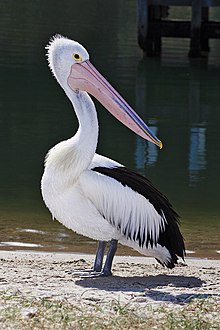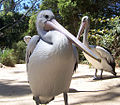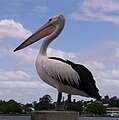Australian pelican
| Australian Pelican | |
|---|---|

| |
| Scientific classification | |
| Kingdom: | |
| Phylum: | |
| Class: | |
| Order: | |
| Family: | |
| Genus: | |
| Species: | P. conspicillatus
|
| Binomial name | |
| Pelecanus conspicillatus Temminck, 1824
| |
The Australian Pelican (Pelecanus conspicillatus) is a large water bird, widespread on the inland and coastal waters of Australia and New Guinea, also in Fiji, parts of Indonesia and as a vagrant to New Zealand.
Taxonomy
The Australian Pelican was first described by Dutch naturalist Coenraad Jacob Temminck in 1824. Its specific epithet is derived from the Latin verb conspicere 'to perceive', hence 'conspicuous'.
Description
The Australian Pelican is medium-sized by pelican standards: 1.6 to 1.8 m (5.3-6 ft) long with a wingspan of 2.3 to 2.5 m (7.6-8.3 ft) and weighing 4 to 10 kg (8.8-22 lb). It is predominantly white with black along the primaries of the wings. The pale, pinkish bill is enormous, even by pelican standards, and is the largest bill in the avian world. The record-sized bill was 49 cm (19.5 in) long.
Distribution and habitat
Australian Pelicans prefer large expanses of open water without too much aquatic vegetation. The surrounding environment is unimportant: it can be forest, grassland, desert, estuarine mudflats, an ornamental city park, or industrial wasteland, provided only that there is open water able to support a sufficient supply of fish.
Australian Pelicans follow no particular schedule of regular movement, simply following the availability of food supplies. When the normally barren Lake Eyre filled during 1974 to 1976, for example, only a handful of pelicans remained around the coastal cities: when the great inland lakes dried again, the population dispersed once more, flocks of thousands being seen on the northern coasts and some individuals reaching Christmas Island, Palau and New Zealand.
The species became first known to occur in New Zealand from a specimen shot at Jerusalem in 1890 and small numbers of subfossil bones, the first found at Lake Grassmere in 1947, followed by records of other stray individuals. The bones were later described as a new (sub)species, Pelecanus (conspicillatus) novaezealandiae (Scarlett, 1966: "New Zealand Pelican") as they appeared to be larger, but Worthy (1998), reviewing new material, determined that they were not separable from the Australian population. These fossils were first found in 1930.
Breeding
The Australian Pelican begins breeding at two or three years of age. Breeding season varies, occurring in winter in tropical areas (north of 26oS) and late spring in parts of southern Australia. Any time after rainfall is usual in inland areas. The nest is a shallow depression in earth or sand, sometimes with some grass lining. Grassy platforms are constructed at Lake Alexandrina in South Australia. Nesting is communal, with colonies located on islands or sheltered areas in the vicinity of lakes or the sea. Breeding Australian pelicans will lay one or three chalky-white eggs measuring 93 x 57 mm, which are often scratched and dirty.[1] After they hatch, the larger one will be fed more, and the smaller one will eventually die of starvation. For the first two weeks the chicks will be fed regurgitated liquid, but for the remaining two months they will be fed fish such as goldfish or the introduced European carp, and some invertebrates. Widespread throughout its large range, the Australian Pelican is evaluated as Least Concern on the IUCN Red List of Threatened Species.
References
- Template:IUCN2006 Database entry includes justification for why this species is of least concern.
- Scarlett, R. J. (1966): A Pelican in New Zealand. Notornis 13(4): 204-217. PDF fulltext
- Worthy, Trevor H. (1998): A remarkable fossil and archaeological fauna from Marfells Beach, Lake Grassmere, South Island, New Zealand. Records of the Canterbury Museum 12: 79-176.
- Australian Pelican - Australian Museum Online
Gallery
-
Some Australian Pelicans at the mouth of the McArthur River
-
Artificial feeding at The Entrance, New South Wales
-
Beach roosting at Moreton Island
-
At Tangalooma, during artificial feeding session
-
Strange behaviour
-
Australian Pelican at Portside Wharf in Brisbane, Queensland
External links
- Pelican videos on the Internet Bird Collection
- BirdLife Species Factsheet
- IUCN Red List
- Australian Museum fact sheet
- Gould's The Birds of Australia plate
- Australian Pelicans at Victor Harbor, South Australia
- ^ Beruldsen, G (2003). Australian Birds: Their Nests and Eggs. Kenmore Hills, Qld: self. pp. p. 187. ISBN 0-646-42798-9.
{{cite book}}:|pages=has extra text (help)









